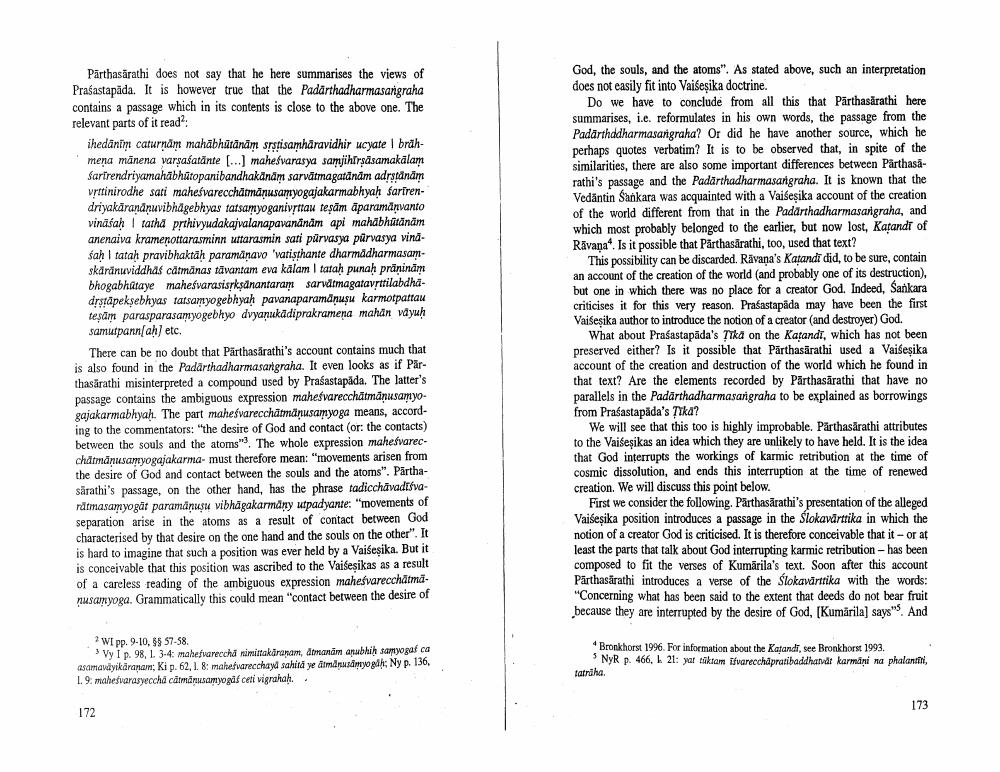Book Title: Mimamsa Versus Vaisesika Author(s): Johannes Bronkhorst Publisher: Johannes Bronkhorst View full book textPage 2
________________ Parthasārathi does not say that he here summarises the views of Prasastapāda. It is however true that the Padarthadharmasangraha contains a passage which in its contents is close to the above one. The relevant parts of it reada: ihedānim caturnam mahābhūtānām srstisamhåravidhir ucyate I brdhmena mānena varşašatante [...) maheśvarasya samjihirsāsamakalam Sartrendriyamahābhūtopanibandhakanām sarvātmagatanám adrstnam vrttinirodhe sati mahesvarecchātmānusamyogajakarmabhyah Sarfrendriyakaranānuvibhdgebhyas tatsamyoganivsttau teşām āparamanvanto vināšahtarha prthivyudakajvalanapavanandm api mahābhūtānam anenaiva kramenottarasminn uttarasmin sati pürvasya parvasya vind sah I tatah pravibhaktah paramänavo 'watisthante dharmadharmasamskårdnuviddhas catmānas tāvantam eva kälam tatah punah präninám bhogabhataye maheśvarasisykşdnantaram sarvdtmagatavsttilabdhadrspeksebhyas tarsamyogebhyah pawanaparamdnusu karmotpattau tepam parasparasamyogebhyo dvyanukadiprakramena mahant wdyuh samutpann an etc. There can be no doubt that Pärthasarathi's account contains much that is also found in the Padarthadharmasangraha. It even looks as if Parthasärathi misinterpreted a compound used by Prasastapāda. The latter's passage contains the ambiguous expression mahesvarecchátmánusamyogajakarmabhyah. The part mahesvarecchätmanusamyoga means, according to the commentators: "the desire of God and contact (or: the contacts) between the souls and the atoms". The whole expression mahesvareccharmanusamyogajakarma must therefore mean:"movements arisen from the desire of God and contact between the souls and the atoms". Parthasärathi's passage, on the other hand, has the phrase tadicchawadiva ratmasamyogāt paramanusu vibhāgakarmány utpadyante: "movements of separation arise in the atoms as a result of contact between God characterised by that desire on the one hand and the souls on the other". It is hard to imagine that such a position was ever held by a Vaišeşika. But it is conceivable that this position was ascribed to the Vaišeşikas as a result of a careless reading of the ambiguous expression mahesvarecchätmapusamyoga. Grammatically this could mean "contact between the desire of God, the souls, and the atoms". As stated above, such an interpretation does not easily fit into Vaiseșika doctrine. Do we have to conclude from all this that Pärthasarathi here summarises, i.e. reformulates in his own words, the passage from the Padarthadharmasangraha? Or did he have another source, which he perhaps quotes verbatim? It is to be observed that, in spite of the similarities, there are also some important differences between Parthasarathi's passage and the Padarthadharmasangraha. It is known that the Vedāntin Sankara was acquainted with a Vaiśesika account of the creation of the world different from that in the Padarthadharmasarlgraha, and which most probably belonged to the earlier, but now lost, Karandi of Rāvana". Is it possible that Parthasarathi, too, used that text? This possibility can be discarded. Rāvana's Katandi did, to be sure, contain an account of the creation of the world and probably one of its destruction), but one in which there was no place for a creator God. Indeed, Sankara criticises it for this very reason. Prasastapäda may have been the first Vai esika author to introduce the notion of a creator and destroyer) God. What about Prasastapāda's Tikä on the katandi, which has not been preserved either? Is it possible that Parthasarathi used a Vaiseşika account of the creation and destruction of the world which he found in that text? Are the elements recorded by Parthasarathi that have no parallels in the Padārthadharmasangraha to be explained as borrowings from Prasastapāda's Tika? We will see that this too is highly improbable. Parthasarathi attributes to the Vaišeşikas an idea which they are unlikely to have held. It is the idea that God interrupts the workings of karmic retribution at the time of cosmic dissolution, and ends this interruption at the time of renewed creation. We will discuss this point below. First we consider the following. Pārthasārathi's presentation of the alleged Vaiseșika position introduces a passage in the Slokavārttika in which the notion of a creator God is criticised. It is therefore conceivable that it - or at least the parts that talk about God interrupting karmic retribution - has been composed to fit the verses of Kumārila's text. Soon after this account Pärthasărathi introduces a verse of the Slokavirttika with the words: "Concerning what has been said to the extent that deeds do not bear fruit because they are interrupted by the desire of God, (Kumarila) says". And 2 WI pp. 9-10,89 57-58. > Vy I p. 98, 1. 3.4: mahervarecha nimittakaranam, dimanam anubhih samyogar ca asamadyikäranamki p. 62, 1. 8: mahefvarecchaya sahitd ye diminusāmyogik: Ny p. 130. 1. 9. mahesvarasyeccha cāmānusamyogaf ceti vigrahah.. Bronkhorst 1996. For information about the Katandi, see Bronkhorst 1993. NyR p. 466, k 21: yar raktam ifvarecchápratibaddhardt karmani na phalantini, tatriha. 173 172Page Navigation
1 2 3 4 5 6
